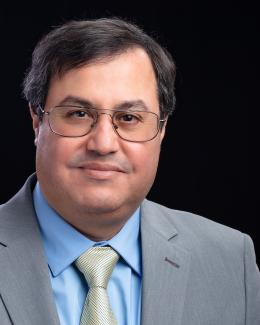ORNL researchers Lu Yu and Yaocai Bai examine vials that contain a chemical solution that causes the cobalt and lithium to separate from a spent battery, followed by a second stage when cobalt precipitates in the bottom. Credit: Carlos Jones/ORNL, U.S. Dept. of Energy
Used lithium-ion batteries from cell phones, laptops and a growing number of electric vehicles are piling up, but options for recycling them remain limited mostly to burning or chemically dissolving shredded batteries. The current state of the art methods can pose environmental challenges and be difficult to make economical at the industrial scale.
The conventional process recovers few of the battery materials and relies on caustic, inorganic acids and hazardous chemicals that may introduce impurities. It also requires complicated separation and precipitation to recover the critical metals. However, recovering metals such as cobalt and lithium could reduce both pollution and reliance on foreign sources and choked supply chains.
Researchers at the Department of Energy’s Oak Ridge National Laboratory have improved on approaches that dissolve the battery in a liquid solution in order to reduce the amount of hazardous chemicals used in the process.
This simple, efficient and environmentally-friendly solution developed by ORNL researchers overcomes the main obstacles presented by previous approaches.
The spent battery is soaked in a solution of organic citric acid – which occurs naturally in citrus fruits – dissolved in ethylene glycol, an antifreeze agent commonly used in consumer products like paint and makeup. Citric acid comes from sustainable sources and is much safer to handle than inorganic acids. This green solution produced a strikingly efficient separation and recovery process for the metals from the positively-charged electrode of the battery, called the cathode.
“Because the cathode contains the critical materials, it is the most expensive part of any battery, contributing more than 30% of the cost,” said Yaocai Bai, a member of the ORNL battery research team. “Our approach could reduce the cost of batteries over time.” The research was conducted in ORNL’s Battery Manufacturing Facility, the country’s largest open-access battery manufacturing research and development center.
The recycling technique developed there leached nearly 100% of the cobalt and lithium from the cathode without introducing impurities in the system. It also enabled efficient separation of the metal solution from other residues. Most importantly, it served a second function by recovering over 96% of the cobalt in a matter of hours, without the typical addition of more chemicals in what is usually a tricky process of manually balancing acid levels.
“This is the first time one solution system has covered the functions of both leaching and recovery,” said lead researcher Lu Yu. “It was exciting to find that the cobalt would precipitate and settle out without further interference. We were not expecting that.”
Eliminating the need for extra chemicals reduces costs and avoids creating byproducts or secondary wastes. “We are glad this recycling process developed by our scientists can pave the way for greater recovery of battery critical materials,” said Ilias Belharouak, corporate fellow and head of the ORNL’s electrification section.
The leaching performance of citric acid and ethylene glycol has been explored before, but that approach used more acid and a lower temperature, which proved less effective, Bai said.
“We were surprised by how quickly the leaching happened in our solution,” Bai said. “With an organic acid, it usually takes 10-12 hours, but this took only one.” Conventional solutions using inorganic acid are also slower because they include water, which has a boiling point that limits the temperature of the reaction.
This research is funded as a project of the Advanced Battery Recycling Consortium, or ReCell, a program of the Vehicle Technologies Office within DOE’s Office of Energy Efficiency and Renewable Energy. Yu, Bai, Belharouak and researchers Rachid Essehli and Anuj Bisht contributed to the study, which utilized the DOE’s Center for Nanophase Materials Science at ORNL.
UT-Battelle manages ORNL for the Department of Energy’s Office of Science, the single largest supporter of basic research in the physical sciences in the United States. The Office of Science is working to address some of the most pressing challenges of our time. For more information, please visit energy.gov/science.






